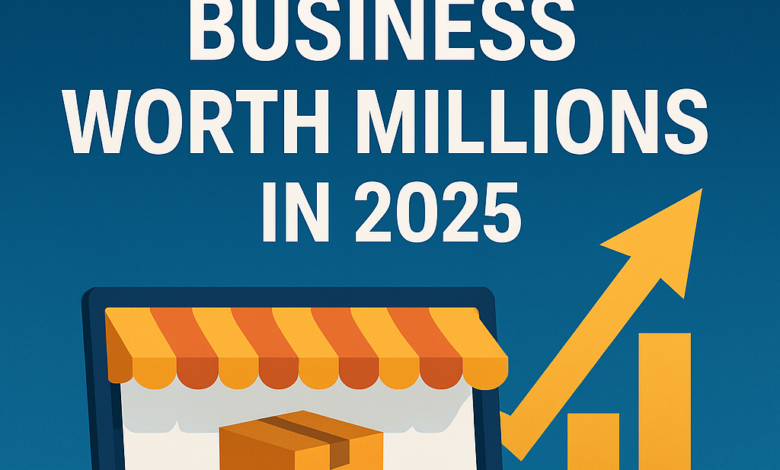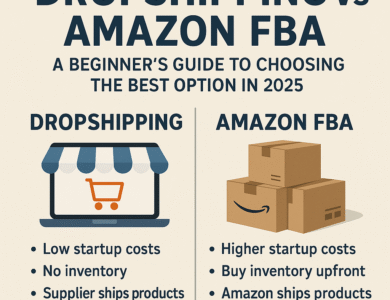Unlocking Success: How To Create A Dropshipping Business Worth Millions in 2025

Starting a dropshipping business can feel overwhelming, especially with all the information out there. But if you’re looking to create a successful dropshipping venture in 2025, you’re in the right place. This guide will break down the steps you need to take, from picking the right niche to scaling your business. It’s all about making smart choices and staying flexible as you learn what works best for you.
Key Takeaways
- Find a niche that has demand but isn’t overly crowded.
- Choose an e-commerce platform that suits your needs.
- Make sure your suppliers are reliable and offer quality products.
- Use social media and SEO to effectively market your store.
- Keep an eye on your performance metrics and adjust as needed.
Identifying Your Niche Market

Okay, so you wanna make millions with dropshipping by 2025? First things first: you gotta figure out what you’re actually going to sell. You can’t just throw a bunch of random stuff online and hope it sticks. That’s like throwing spaghetti at the wall and hoping it becomes a gourmet meal. It’s all about finding that sweet spot – a niche market that’s got demand, but isn’t so crowded you can’t even breathe. Let’s break it down.
Understanding Market Demand
Is anyone even buying what you’re thinking of selling? Sounds obvious, but you’d be surprised. You need to do some digging. Google Trends is your friend here. See if there’s actual search volume for the products you have in mind. Are the searches trending up, down, or staying steady? Up is good, down is bad, steady could be okay, depending. Also, think about seasonal trends. Selling Christmas sweaters in July? Probably not the best idea. Selling Halloween costumes in November? Same deal. You need to find profitable product ideas that people want, when they want them.
Analyzing Competition
Alright, so people want what you’re selling. Great! Now, who else is selling it? Are you going up against Amazon and Walmart? If so, good luck. You need to see how many other dropshippers are in your space. A little competition is fine – it validates the market. But too much, and you’ll be fighting an uphill battle. Check out their websites, their pricing, their marketing. What are they doing well? What are they doing badly? How can you do it better? Can you differentiate your business from other ecommerce brands? That’s the key.
Choosing a Profitable Niche
This is where it all comes together. You’ve looked at demand, you’ve sized up the competition. Now it’s time to pick your winner. Ideally, you want a niche that’s got decent demand, not too much competition, and something you’re actually interested in. Passion counts for something, believe it or not. If you’re bored to tears by your products, you’re gonna have a hard time marketing them. Think about your own hobbies and interests. What do you already know a lot about? What problems do people in that niche have that you could solve with a product? This is how you build your brand and stand out from the crowd.
Don’t be afraid to get specific. Instead of
Building Your Online Store
Alright, so you’ve got your niche picked out, now it’s time to actually build your online store. This is where things get real. You’re not just dreaming anymore; you’re creating a place where people will (hopefully) hand over their hard-earned cash. No pressure, right?
Selecting the Right E-commerce Platform
Choosing your e-commerce platform is a big deal. It’s like picking the foundation for your house. You want something solid, reliable, and that fits your needs. There are a bunch of options out there, each with its own pros and cons. Shopify is super popular and easy to use, especially if you’re just starting out. It’s got a ton of apps and themes to customize your store. Then there’s WooCommerce, which is great if you’re already familiar with WordPress. BigCommerce is another solid choice, especially if you’re planning on scaling up quickly. Don’t forget to check out platforms like Wix or Squarespace either, they are getting better and better every year. Take your time, do your research, and pick the one that feels right for you.
Designing an Engaging User Experience
Okay, so you’ve got your platform sorted. Now, let’s talk about making your store look good and, more importantly, easy to use. Think about it from the customer’s point of view. When they land on your site, what do they see? Is it cluttered and confusing, or clean and inviting? You want to make it as easy as possible for them to find what they’re looking for and make a purchase. Here are a few things to keep in mind:
- Keep it simple: Don’t overload your pages with too much stuff. A clean, minimalist design is often the best way to go.
- Make it easy to navigate: Use clear and concise menus and categories so people can find what they need quickly.
- Use high-quality images: Product photos are super important. Make sure they’re clear, well-lit, and show off your products in the best possible light.
- Mobile-friendly is a must: Most people will be browsing your store on their phones, so make sure your site looks good and works well on mobile devices.
User experience is key. If people have a bad time on your site, they’re not coming back. Make it easy, make it enjoyable, and they’ll be much more likely to buy something.
Integrating Payment Solutions
Last but not least, you need to make sure people can actually pay you! Integrating payment solutions is a critical step. You need to offer a variety of payment options to cater to different customers. PayPal is a must-have, as it’s widely used and trusted. Credit and debit card processing is also essential. You can use services like Stripe or Square to handle this. Consider offering other options like Apple Pay, Google Pay, or even cryptocurrency if it aligns with your target audience. Make sure the checkout process is smooth and secure. Nobody wants to enter their credit card details on a sketchy-looking site. Display trust badges and security certificates to reassure customers that their information is safe. Test the payment process thoroughly to make sure everything works correctly. Nothing is worse than losing a sale because of a technical glitch at checkout.
Sourcing Quality Products
Alright, so you’ve got your niche, your store’s looking sharp, now comes the part where you actually get stuff to sell. This is super important because if your products are junk, your whole dropshipping empire is gonna crumble faster than a stale cookie. No pressure, right?
Finding Reliable Suppliers
Finding suppliers is like dating – you gotta shop around before you commit. Don’t just jump at the first shiny website you see. Do your homework. Look for suppliers who have been in the game for a while and have a solid reputation. Check out their online presence, read reviews (but take them with a grain of salt), and see if they’re responsive to inquiries. A good supplier is a partner, not just some random warehouse.
Here’s a few things to consider:
- Experience: How long have they been in business?
- Communication: Are they easy to get a hold of and quick to respond?
- Product Range: Do they offer a variety of products within your niche?
- Location: Where are they located? This can affect shipping times and costs.
Diversifying your suppliers is a smart move. Don’t put all your eggs in one basket. If one supplier runs out of stock or has quality issues, you’ll have backups to keep your business running smoothly.
Evaluating Product Quality
Okay, you’ve found some potential suppliers, but how do you know if their products are any good? Simple: order samples! I know, it costs money, but it’s way better than getting a bunch of angry customers complaining about broken or defective stuff. When you get the samples, put them through their paces. Test them out, see how they hold up, and make sure they match the descriptions on the supplier’s website. If you’re selling clothes, check the stitching and fabric quality. If you’re selling electronics, make sure they work properly and don’t feel cheap. Basically, pretend you’re a super picky customer and see if the products pass the test.
Negotiating Terms and Pricing
Alright, you’ve found a supplier with quality products. Now it’s time to talk money. Don’t be afraid to negotiate! Most suppliers are willing to work with you, especially if you’re planning on ordering in bulk. Ask about discounts, payment terms, and shipping costs. See if you can get a better price per unit if you commit to a certain order volume. Also, make sure you understand their return policy and warranty information. You don’t want to get stuck with a bunch of defective products that you can’t return. Remember to check out customer reviews to see what others are saying about the supplier’s reliability and product quality.
Here’s a quick rundown of things to negotiate:
- Price per unit: Can you get a discount for bulk orders?
- Shipping costs: Can you get free or reduced shipping?
- Payment terms: Can you get extended payment terms?
- Return policy: What is their return policy for defective products?
- Warranty: Do they offer a warranty on their products?
Implementing Effective Marketing Strategies
Marketing is super important for dropshipping. You can have the best products and a great website, but if nobody knows about it, you won’t make any sales. It’s all about getting your products in front of the right people. Let’s look at some ways to do that.
Utilizing Social Media Advertising
Social media is a goldmine. Platforms like Facebook, Instagram, and TikTok let you target specific demographics, interests, and behaviors. This means you can show your ads to people who are most likely to buy your products. Start with a small budget and test different ads to see what works best. Don’t forget to track your results so you can refine your campaigns over time. You can also use tools to automatically import products into your store.
Leveraging Influencer Partnerships
Influencers have built-in audiences that trust their recommendations. Find influencers in your niche and partner with them to promote your products. This could involve sponsored posts, product reviews, or even giveaways. Micro-influencers (those with smaller, more engaged audiences) can often be more effective and affordable than big celebrities. Make sure the influencer’s audience aligns with your target market.
Optimizing SEO for Your Store
SEO, or Search Engine Optimization, is about making your store easier to find on search engines like Google. This involves using relevant keywords in your product descriptions, titles, and website content.
Think about what people would search for when looking for your products and use those words. Also, make sure your website is mobile-friendly and loads quickly, as these are important ranking factors. Don’t forget to stay in touch with customers to build trust.
Here are some SEO basics:
- Keyword Research: Find out what terms people are searching for.
- On-Page Optimization: Use keywords in your titles, descriptions, and content.
- Link Building: Get other websites to link to yours.
Consider starting a newsletter to engage with customers regularly.
Managing Customer Relationships

Okay, so you’ve got your store up and running, products are sourced, and marketing is bringing people in. Now what? It’s all about keeping those customers happy! This is where managing customer relationships becomes super important. It’s not just about making a sale; it’s about building loyalty and getting repeat business. Think of it as making friends, but with a business twist.
Providing Excellent Customer Service
Good customer service can make or break your dropshipping business. People remember how you make them feel. Quick responses to questions, friendly support, and going the extra mile can turn a one-time buyer into a lifelong fan. Make sure your contact information is easy to find, and be ready to handle inquiries through email, chat, or even phone. Consider setting up a FAQ page to address common questions. It’s also a good idea to use a customer communication platform to keep track of everything.
Handling Returns and Refunds
Returns and refunds are a fact of life in e-commerce. How you handle them can significantly impact your reputation. Have a clear and easy-to-understand return policy. Be fair and prompt in processing refunds. Sometimes, it’s better to eat a small loss to keep a customer happy. Consider offering store credit or a discount on their next purchase as an alternative to a full refund. Here’s a simple breakdown:
- Clearly state your return policy on your website.
- Provide a straightforward return process.
- Respond to return requests quickly.
- Offer options like refunds, exchanges, or store credit.
Remember, a smooth return process can turn a potentially negative experience into a positive one. It shows you value your customers and are willing to stand behind your products.
Building Customer Loyalty
Building customer loyalty is the holy grail of any business. It’s cheaper to keep an existing customer than to acquire a new one. Here are a few ways to build that loyalty:
- Personalize the experience: Use customer data to tailor your marketing messages and product recommendations.
- Reward repeat customers: Implement a loyalty program with points, discounts, or exclusive offers.
- Engage on social media: Interact with your customers on social media, respond to comments, and run contests.
- Ask for feedback: Regularly solicit feedback from your customers to improve your products and services.
Think about sending out personalized thank-you notes with orders, or offering exclusive early access to new products for your most loyal customers. These small gestures can go a long way in creating a strong bond and turning customers into advocates for your brand. Don’t forget to engage with customers regularly!
Analyzing Business Performance
Okay, so you’ve got your dropshipping store up and running. Now comes the part where you actually see if all your hard work is paying off. It’s not just about making sales; it’s about understanding what’s working and what’s not. This is where analyzing your business performance comes in. Let’s break it down.
Tracking Key Performance Indicators
KPIs are your best friends. They’re the vital signs of your business. You need to know what to keep an eye on. Here are a few to get you started:
- Conversion Rate: What percentage of visitors are actually buying something?
- Average Order Value: How much is each customer spending on average?
- Customer Acquisition Cost: How much does it cost you to get a new customer?
- Website Traffic: How many people are visiting your store?
- Bounce Rate: How quickly are people leaving your site after arriving?
Using Analytics Tools
You can’t track KPIs without the right tools. Google Analytics is a must-have. It’s free and gives you a ton of data about your website traffic, user behavior, and more. Also, check what analytics your e-commerce platform provides. Shopify, for example, has its own built-in analytics dashboard. Use these tools to monitor your KPIs and identify trends.
Adjusting Strategies Based on Data
Okay, you’re tracking your KPIs, and you’re using analytics tools. Now what? Well, you need to actually do something with that data. If your conversion rate is low, maybe you need to improve your product descriptions or your website design. If your customer acquisition cost is too high, maybe you need to rethink your marketing strategy. Don’t be afraid to experiment and make changes based on what the data is telling you.
Analyzing your business performance isn’t a one-time thing. It’s an ongoing process. You need to constantly monitor your KPIs, analyze your data, and adjust your strategies as needed. That’s how you’ll turn your dropshipping store into a million-dollar business.
Scaling Your Dropshipping Business
Okay, so you’ve got your dropshipping store up and running. Sales are coming in, and things are looking good. But how do you take it to the next level? How do you go from a decent side hustle to a real money-making machine? That’s where scaling comes in. It’s not just about doing more of the same; it’s about making smart changes to grow your business efficiently.
Expanding Product Lines
One of the most straightforward ways to scale is by adding more products to your store. But don’t just add anything! Think strategically. What are your current customers already buying? What complements those products? Look for items that fit your niche and offer good profit margins. Consider surveying your existing customer base to gauge interest in potential new product categories.
- Research trending products within your niche.
- Analyze customer purchase patterns to identify complementary items.
- Test new products with small-scale promotions before fully committing.
Automating Operations
As your business grows, you’ll quickly find yourself spending more and more time on repetitive tasks. This is where automation comes in. Think about automating things like order fulfillment, customer service, and even marketing. There are tons of tools out there that can help you streamline these processes and free up your time to focus on more important things.
Automating your dropshipping business is not just about saving time; it’s about reducing errors and improving efficiency. By automating repetitive tasks, you can minimize the risk of mistakes and ensure that your business runs smoothly, even as it grows.
- Implement automated email marketing campaigns.
- Use order fulfillment software to streamline processing.
- Automate social media posting and engagement.
Exploring New Market Opportunities
Don’t limit yourself to just one market. Once you’ve established a solid foundation, start looking for new opportunities to expand your reach. This could mean targeting new geographic regions, exploring different customer segments, or even selling your products on new platforms. The key is to be adaptable and willing to experiment.
| Market | Potential | Challenges |
|---|---|---|
| International | High growth potential | Shipping costs, language barriers |
| New Platforms | Reach wider audience | Platform fees, competition |
| Niche Markets | Less competition | Smaller target audience |
Wrapping It Up: Your Path to Dropshipping Success
So, there you have it. Building a dropshipping business in 2025 can be a game changer if you play your cards right. It’s not just about picking a product and hoping for the best. You need to choose a niche that excites you, market it well, and keep an eye on trends. Sure, it might take some time to see real profits, but with the right mindset and a bit of hustle, you can make it happen. Remember, every big success starts with a small step. So why not take that step today? Your million-dollar dropshipping venture could be just around the corner.
Frequently Asked Questions
What is dropshipping?
Dropshipping is a way to sell products without keeping them in stock. When someone buys from your store, you order the item from a supplier who ships it directly to the customer.
How do I choose a niche for my dropshipping business?
To pick a niche, think about what interests you. Look for products that are in demand but not too many people are selling. This way, you can stand out in the market.
Can I start dropshipping with no money?
Yes, you can start dropshipping with little or no money. You don’t need to buy inventory upfront, but you may need to spend on a website and marketing.
How long does it take to make money in dropshipping?
Many people start seeing profits within a few weeks of launching their store, but it can take longer depending on your marketing and product choices.
Is dropshipping a good business model?
Yes, dropshipping can be a good business model. It has low startup costs and allows you to test different products without a big financial risk.
How can I market my dropshipping store?
You can market your store using social media, influencer partnerships, and search engine optimization (SEO) to attract more visitors and increase sales.



